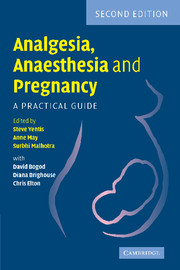Book contents
- Frontmatter
- Contents
- List of contributors
- Preface
- SECTION 1 PRECONCEPTION AND CONCEPTION
- SECTION 2 PREGNANCY
- I Procedures in early/mid-pregnancy
- II Normal pregnancy and delivery
- III Operative delivery and third stage
- IV Anaesthetic complications
- V Problems confined to obstetrics
- VI Problems not confined to obstetrics
- VII The neonate
- SECTION 3 PUERPERIUM AND AFTER
- SECTION 4 ORGANISATIONAL ASPECTS
- Index
VII - The neonate
Published online by Cambridge University Press: 10 November 2010
- Frontmatter
- Contents
- List of contributors
- Preface
- SECTION 1 PRECONCEPTION AND CONCEPTION
- SECTION 2 PREGNANCY
- I Procedures in early/mid-pregnancy
- II Normal pregnancy and delivery
- III Operative delivery and third stage
- IV Anaesthetic complications
- V Problems confined to obstetrics
- VI Problems not confined to obstetrics
- VII The neonate
- SECTION 3 PUERPERIUM AND AFTER
- SECTION 4 ORGANISATIONAL ASPECTS
- Index
Summary
NEONATAL ASSESSMENT
Formal assessment of the newborn baby is important to allow documentation of the neonate's general state of wellbeing; as a prognostic exercise, to identify neonates at risk and focus medical attention on them; possibly as a means of following progress over time; and as a research tool for determining the effects of various interventions or conditions on neonatal outcome (e.g. drug therapy, anaesthetic techniques, epidemiological factors). Various methods have been described; as far as obstetric anaesthesia is concerned the important ones are those that focus on the neonate's gross physiological status at or shortly after birth and those that assess its neurobehaviour.
Problems/special considerations
The easier the system for assessment (and therefore the more attractive it is to busy clinicians), the less its ability to discern subtle differences and thus the less useful it is as a tool, especially when the effects being studied are likely to be small (e.g. a possible difference in effects of two similar drugs in labour). Conversely, tiny differences revealed by very sensitive measurements may be of uncertain significance clinically. In addition, factors that might ordinarily be prognostic may be susceptible to the actions of anaesthetic agents, e.g. ketamine may be associated with falsely high scores when using systems that rely heavily on muscle tone.
Methods of assessment
Measures of overall physiological status
Time to sustained respiration (TSR): the time between delivery and sustained spontaneous ventilation is a very crude indicator of neonatal wellbeing but does indicate babies that need special attention and attempts to quantify the degree of impairment.
- Type
- Chapter
- Information
- Analgesia, Anaesthesia and PregnancyA Practical Guide, pp. 326 - 336Publisher: Cambridge University PressPrint publication year: 2007



